President's Message
We are very excited about resuming our quarterly meetings on September 12, 2021 at the Libbie Mill Library.
Henrico County has resumed in-person meetings and programming.
The usual precautions will be taken.
A brief health self-screening is required for entry to the library. Face coverings are required for all Henrico County buildings and areas of the library, including meeting and study rooms. Seating will be spaced.
While our committees have been busy behind the scene, it is not the same as sharing our enthusiasm for history with like-minded folks. We look forward to seeing you!
In reference to enthusiasm for history, congratulations are in order for Henrico's neighbor, Hanover County, which will celebrate its 300th birhday on Saturday, August 28, 2021, highlighted by the opening of the Hanover County Museum of History & Culture on the grounds of the historic Hanover Courthouse. The Board of Supervisors will cut the ribbon on the new museum at 9:30 a.m. This event will be held from 9:30 a.m. to 1 p.m., with a rain date of Sunday, August 29, from 12-4.
The area that became Hanover County is reported to have once been a hunting ground for the Pamunkey and Chickahominy Native American tribes. The area was settled by English plantation owners and tobacco farmers in the late 17th century. Hanover County was officially formed by the Virginia General Assembly on November 26, 1720, through an act dividing New Kent County. It was named in honor of King George I of England, who, at the time of his coronation, was Elector of Hanover in Germany. Part of Hanover became Louisa County in 1742.
Henrico itself was divided into 9 other counties and part of a 10th:
Goochland, founded in 1728; Albemarle in 1744; Chesterfield and Cumberland in 1749; Amherst and Buckingham in 1761; Fluvanna and Powhatan in 1777; Nelson in 1807; part of Appomattox, in 1845. The cities of Richmond, Charlottesville, and Colonial Heights were also formed from Henrico.
Hanover and Henrico counties have another not so apparent association other than being neighbors and both having a long history - that of Patrick Henry.
Patrick Henry (orator of the libery or death" fame of the American Revolution and Governor of Virginia) was born in Hanover County and lived at his home, Scotchtown, for much of the American Revolution.
Interestingly, cousins of the Sheppard family of Meadow Farm in Henrico County would later own Scotchtown. Ownership of the property remained with Sheppard family descendants until it was purchased and restored by Preservation Virginia. It is the only original home of Patrick Henry still standing.
A little known fact is that at the time of Patrick Henry's famous speech, the area of St. John's Church was still under Henrico County jurisdiction. The town of Richmond (still part of Henrico) was incorporated into a city in 1782 was not completly independent until 1842.
In January 1775, the notice went out for the Second Virginia Convention to meet at "Richmond, Henrico County" on March 20.
Seemingly unassociated circumstances have a significant impact in the course of history.
Kudos and best wishes to "Hanover County Museum of History & Culture" and the preservation of their history, for otherwise much knowledge is ultimately lost in time.
Sarah Pace
President
>Back to Top<
September Quarterly Meeting
Our next meeting is Sunday, September 12, starting 2:30 p.m.
It will be at the Libbie Mill Library, which is located at 2100 Libbie Lake E. St, in Henrico, VA 23220.
Our speaker will be Dr. Nathan L. Taylor. He is the Executive Director of Virginia Baptist Historical Society and The Center for Baptist Heritage and Studies, and University of Richmond Archivist. Dr. Taylor will speak on Virginia contributions in Advancing Religious Liberty.
>Back to Top<
Election of HCHS Officers
The following positions will be voted on at the September meeting:
- President: Sarah Pace
- Vice President: Allan Wagner
- Treasurer: Dana Hansen
- Secretary: Tinky Keen
The position of Director of the Fairfield District serving a 3-year term is open for nomination.
>Back to Top<
In Memorium: Dr. Louis Henry Manarin
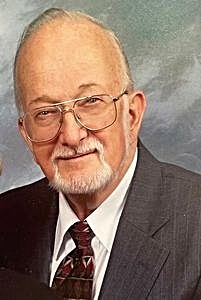
Dr. Louis Henry Manarin, August 20, 2021
>Back to Top<
What's Cooking at Meadow Farm
The date is set, and the plans are in. By the spring of next year, we should be able to visit the kitchen for Meadow Farm. To the right, you will find the four elevations for the building's exterior. The next newsletter will carry the interior floor plans. We look foward to this important addition to our county's historic treasures.
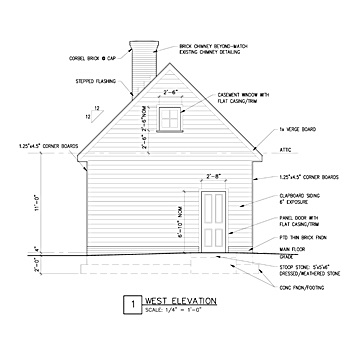
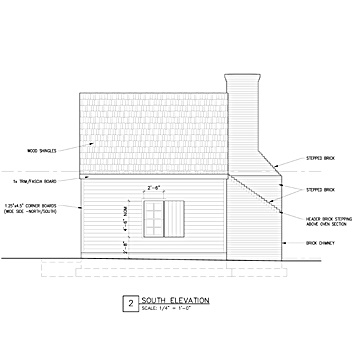
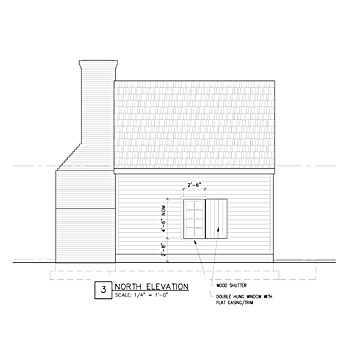
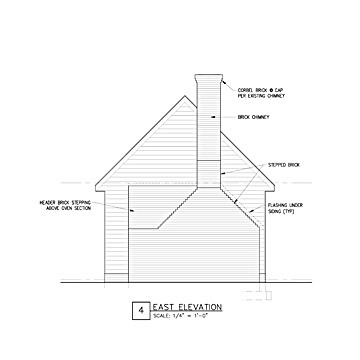
>Back to Top<
Inventive Henricoans
It's a bit hard to believe that a patent was actually issued for a spoon. After all, it seems impossible to attempt to improve something that is so elegantly functional. But John Brereton's design is interesting and would certainly add flair to any table for a seafood dinner.
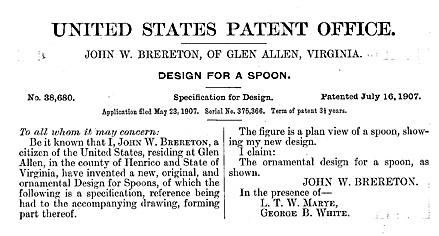
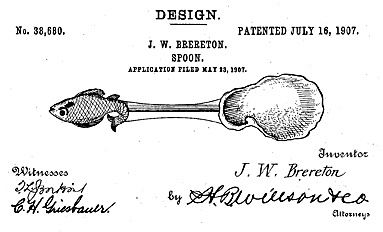
>Back to Top<
For Three to Four Days at a Time at Fairfield Track, It was Off to the Races
Drive four blocks east of Mechanicsville Turnpike on Fairfield Avenue, and you will enter the Peter Paul neighborhood, an area in the City of Richmond of about twenty-five blocks bounded by Fairfield Avenue, Peter Paul Boulevard, V Street and North 21st Street. This urban area certainly does not appear to be horse racing territory. But flip the calendar back about two and a half centuries and the homes will disappear, the city boundaries will shift, and you would be entering the grounds of the Fairfield Race Course, a then well-known racing venue in old Henrico County.
Newspaper announcements an accounts of races at the track can be found from the earliest years of the 19th century, but it seems to have an even earlier genesis. In his Richmond: The History of a City, by Virginius Dabney notes three early race tracks in the Richmond area: Tree Hill (at Tree Hill Farm), Broad Rock (now the site of McGuire Hospital), and the Fairfield Race Course, which he claims is “the oldest, dated from the Revolution or before."
It seems possible that this is the race course that is referred to in the 30 September 1773 Virginia Gazette announcement that a purse of seventy pounds was "TO be run for on Shocko Hill in the Town of Richmond, the second Thursday in November (being the first day of the Fair of the said Town) by any Horse, Mare, or Gelding that never won or started for a Purse or Course Match of 10 1. Value." The race was to be comprised of two-mile heats, with the first horse to claim two heats taking the purse. All horses fourteen hands high would carry 140 pounds of weight with 14 pounds added or reduced for the first inch above or below that height and the seven- pound adjustment for each additional inch, as measured by James Gunn. A shorter announcement for a similar race at "The Fair in Richmond Town" officiated by James Gunn was announced the following year in the 1 April 1774 Virginia Gazette.
Whether this is the Fairfield course or not, by the turn of the century, the races at Fairfield were well known enough to serve as a place for potential buyers to assess horses. And advertisement in the 2 April 1802 Virginia Argus touts the quality and pedigree of a chestnut stud horse named Sans Culottes at "Mr Randolph's plantation on Staunton River." Additionally, it offers several "BLOOD MARES, COLTS and FILLIES of the most valuable description- some of them will be shown at the Fairfield races."
The Fairfield Races seem to have become a fixture of the Virginia racing circuit with races run over the course of three to four days. The 24 March 1804 Virginia Argus announced that the upcoming three days of racing over the Fairfield Course were to begin on April 30th. Monday would feature a sweepstakes for "colts four years old" with two- mile heats. Five were entered at 300 dollars each, and those subscriptions comprised the purse. On the same day the course hosted
The Fairfield Jockey Club Cup, two mile heats free for all age horses belonging to members of the club. This, it seems, provided the owner/members to wager among themselves rather than race for purse. Tuesday would see four-mile heats for the Jockey Club purse of 400 dollars. The Wednesday raise would be three-mile heats ran for the "Purse of the proprietor of the course," a man by the name of E. Smock.
Similar slates of races over three and four days were regularly scheduled at the track; and the Fairfield Jockey Club, sponsors or the races, were clearly well respected in horse racing circles. When the Hanover Jockey Club was organized in 1806, the 15 August Enquirer announced the club's sponsoring of two days of racing, noting that "The regulations with respect to weights, &c. are adopted from those of the Fairfield Jockey Club."
The 19 September 1806 Enquirer advise race attendees that they would have access to "the Dining House and Booths in the field" that could be rented. Admission is a bit hard to ascertain because the announcement added that "Toll will be received at the gate as formerly--foot passengers admitted gratis."
May 1808 races would find the Fairfield Race Course “in elegant order,” according to its announcement in the 1 April Enquirer, because it is now featured "a handsome two story dining house and judges stand, communicating with each other," which had been "erected at considerable expense." But Mr. Smock, the proprietor and treasurer, may have been experiencing some difficulty covering those expenses because he ironically added, "The Treasurer thinks it is unnecessary to remind the members of paying up their back arrearages, as so little attention has been paid to former notice this time kind."
The last newspaper announcement of the Fairfield Races seems to be in 1816, after which the track remained inactive until 1832, when 25 April Richmond Whig and Commercial Journal ran an article entitled "Fairfield Course." It began, "This old and famous course, has been revived, after seventeen years’ suspension," and went on to say that the "concourse was large for the first day, and every appearance indicated that the enterprise of resuscitating Fairfield will be completely successful." Primero, owned by a Mr. Adams, won the sweepstake with two consecutive winning heats.
Aside from the racing, gambling in other forms also seemed prevalent at the track. The 19 October 1833 Alexandria Gazette congratulated the Richmond Compiler, a semi-weekly in its maiden year, because it "courageously attacks the Faro Banks, roulette Tables, &c. &c on a Fairfield Race course." It also hinted at a bit of political hypocrisy because it will to say, "The House of Delegates ex officio pass resolutions against the Bank of the United States and laws against Faro Banks, but members generally like to have their pockets lined with notes of the one, to spend on the other-sub rosa."
In its life before the temporary hiatus, the Fairfield course had apparently been only for male race fans, as the 27 September Enquirer's advertisement indicated that "Every possible attention will be paid for the accommodation of the Gentlemen." It apparently took the new management of the track a significant stretch of time before offered accommodations for women. Advertising races in the 26 September 1853 Daily Dispatch, Proprietor John Belcher announced, "The LADIES' PAVILION has been completed, and an efficient officer appointed to preserve strictest order. No charge will be made for their entrance to the Course." However, no women would "be admitted to the house unless accompanied by a gentleman.
The six October 1853 Daily Dspatch" announced that month's races and noted a "Gate fee" of fifty cents. In addition, it indicated that "Gentlemcan procure BADGES for the purpose of entering the Quarter Stretch at a charge of five dollars for the week," an extra somewhat like a pit pass to a NASCAR race today.
The ladies and gentlemen in attendance at the races witnessed horses whose names were as interesting as today's equine stars are. The 30 September 1853 Daily Dspatch" covered races at the course; and looking forward to the following season's potential entries. Those horses included those dubbed White Eye, Lady Fairfield, Nina, Die Claperton, One Eye Joe, Tom Walker, Commodore, Red Eye, Lawson and Granite.
Announcements run in the Daily Dspatch" during the last week of May and the first week of June 1854 expressed a bit of guarded optimism for the future of the track. Looking four years into the future doctor R. H. Cabell, President of the Fairfield Jockey Club, announced a Great Produce Stake Race" that was to be run in the spring of 1858. However, there was a hint of concern in the P.S. to the ad, which said "the members have agreed, that in case there should be no racing on the Fairfield Course in the Spring of 1858, then the race [is] to come off over some other course adjacent to Richmond." The concern was apparently unfounded because there was racing in the spring of that year at the course.
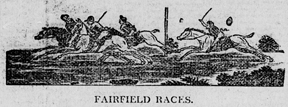
Race announcement: This illustration was regularly used in the Enquirer ads for the Fairfield Races, even being turned on its side for single column announcements.
But a number of changes apparently had to be made to allow those races. As the 20 September 1854 Daily Dspatch" reported, "The Fairfield Jockey Club closes its career this fall, after which the track will probably go into the hands of James Tall[e]y." The article's author indicated that the track's accommodations needed a great deal of improvement and expressed hope that "Mr. Tall[e]y will go to work and make such modern improvements as will render the old race horse stamping ground attractive to the lovers of turf sports."
The Fairfield Jockey Club reorganized in 1856, and apparently measures to continue the racing there. There were also changes made in some practices at the track, like starting races an hour later to facilitate attendance by the business portion of the community and the elimination of "Stand Treats". Those treats were refreshments for club members, paid for by retaining five percent from stakes and purses. The 3 May 1858 Daily Dspatch" noted that "Every club should provide for 'stand treats' out of membership tickets and entrance fees, and when it gets too poor to do that, the sooner a dissolution is effected the better."
Unfortunately, that dissolution was on the horizon. After James Talley's death, the course's lease was auctioned on 10 January 1859, and only sporadic racing continued there. It even served as a venue for a prizefight described in 15 August 1865 Norfolk Post, and baseball practice ground. The 20 September 1866 Daily Dspatch"announced that the Arlington Base-Ball Club would "meet at their grounds, on the Fairfield Race Course, this afternoon at 3 o'clock for practice." And finally, the only references to the racecourse were as a landmark to indicate where land was for sale, where objects had been lost or where lost animals had strayed. Over the ensuing years the property changed hands, eventually being brought by Peter Paul, whose name still graces the community on that land.
Since no pictures or illustrations or even very detailed descriptions seemed to exist of the track, we must rely on a reminiscence in the 7 January 1906 Times-Dispatch fifty years after the track's disappearance to tell us what was there. In the article, Charles M. Wallace, Sr. gave this description: "The track was embraced within the circle of a mile by a low fence of scantlands placed horizontal, upon uprights with open spaces between the A frame house with open galleries on the second story stood close to one of the eastern areas of the circle ... There was a refreshment stand in the lower story of the barn like structure."
When I drove out to the Peter Paul area, I rolled down the window and heard cars rolling by; but I thought about the sound of hoof beats and cheers that had once filled the air.
Joey Boehling
Three views of the Fairfield Race Course's location: The 1910 map, below, indicates the former course's location, now the Peter Paul community. The Smith map of Henrico County in the, second below, labels the location. In the upper right area and above the track is the notation of one of the last owners, John Talley. The bottom map is a detail from the 1862 position map prepared for Major George B. McClellan.
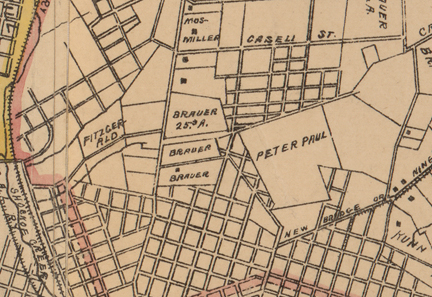
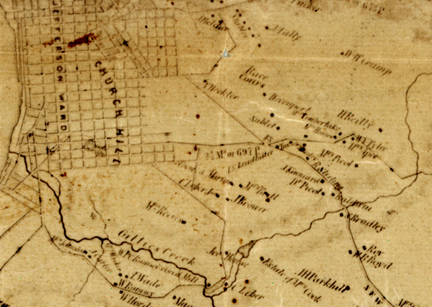
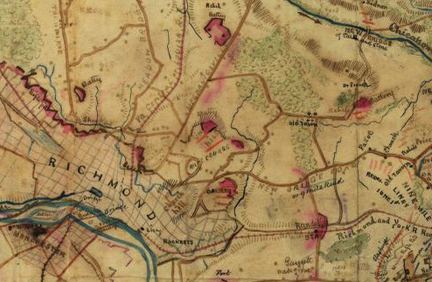
1867 U.S. Army Engineers Map of Richmond: This map gives a good indication of the track's location in its last days of existence. The diagonal road to the left of the track is Mechanicsville Turnpike.
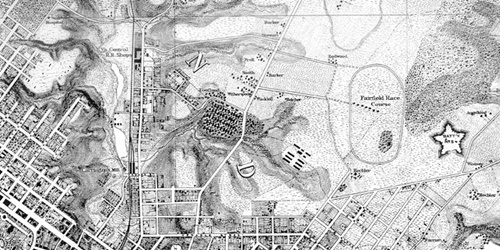
>Back to Top<
What Do You Know?
This wooden object is 4 inches in diameter and 2 1/2 inches tall. The opening in the top is 1 inch in diameter.
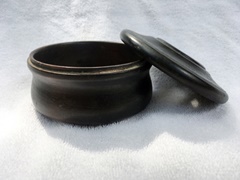
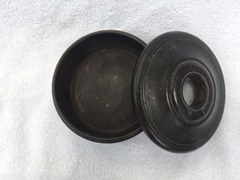
Do you know what it is?
Email your answers to jboehling@verizon.net.
>Back to Top<
Now You Know - It's Crystal Clear
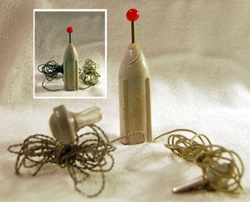
We congratulate Anne Jackson and Mary Jo and Haywood Wigglesworth, who correctly identified the "What Do You Know" object from the last newsletter as a crystal radio. This rocket-shaped radio was pictured with the earphone and alligator clip obscured behind the radio itself in order to make the readers' "guesswork" a little more difficult.
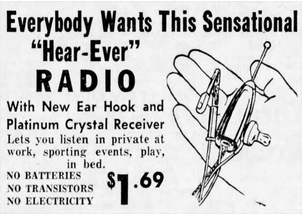
The radio pictured above is a vintage 1950s model with a contemporary ad shown right. Operation was simple: attach the alligator clip to a metal objct that would act as a ground, insert the earphone in your ear and listen. No tuning was necessary, or even possible with this particular device. No batteries were required and only AM radio could be received.
Crystal radios were developed in the early 1900s. This simple radio receiver did not need a power supply; the sound power that came from the earphone actually came from the transmitter of the radio station that was broadcasting. The antenna collected the electromagnet waves sent out by the broadcaster. From there they went to the crystal detector, which allowed the earphone to use the energy.
Because the amount of power was so small, only an earphone and not a loudspeaker could be used, and the radio station had to be fairly close by.
Space age design: The launch of Sputnik and the ensuing "Space Race" inspired all sorts of product designs like thes two radios from the period.
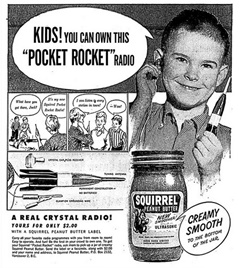
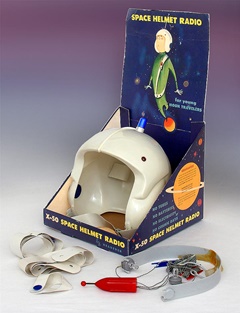
>Back to Top<
News 2021: Third Quarter
First Quarter | Second Quarter | Fourth Quarter
Home | Henrico | Maps | Genealogy | Preservation | Membership | Shopping | HCHS
|











